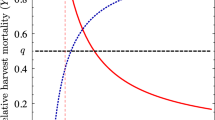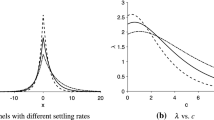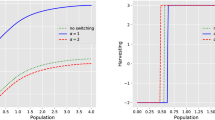Abstract
A long standing question in range management concerns the relative importance of the stocking rate versus the length oftime during which animals graze a particular rangeland. Weaddress this question by analyzing the problem faced by a privaterancher who wishes to minimize the long run expected net unit cost (LRENC) from range operations by choosing either the stocking rate or the length of time during which his animals graze hisrangeland. We construct a renewal-theoretic model and show that,in general, this rancher's LRENC with an optimally chosen stocking rate is lower than his LRENC with an optimally chosen grazing cycle length. From a management perspective, this means that correct stocking of the range is more important than the length of time during which animals graze the range. In addition, our research shows how to address questions concerning the desirability of temporal versus non-temporal controls in managing naturalresources such as fisheries and hunting grounds.
Similar content being viewed by others
REFERENCES
Arrow, K. J. and S. S. L. Chang (1980), ‘Optimal Pricing, Use, and Exploration of Uncertain Natural Resource Stocks’, in P. T. Liu, ed., Dynamic Optimization and Mathematical Economics. New York, NY, USA: Plenum Press.
Batabyal, A. A. (1995), ‘Leading Issues in Domestic EnvironmentalRegulation: A Review Essay’, Ecological Economics 12, 23–39.
Batabyal, A. A. (1999), ‘Aspectsof the Optimal Management of Cyclical Ecological-Economic Systems’, Ecological Economics 30, 285–292.
Batabyal, A. A. and H. Beladi (2000a), ‘Aspects of the Theory of Financial Risk Management forNatural Disasters’, Applied Mathematics Letters, Forthcoming.
Batabyal, A. A. and H. Beladi (2000b),‘Time Restrictions in Natural Resource Management: A Dynamic and Stochastic Analysis’, Unpublished Manuscript. Rochester Institute of Technology.
Goodloe, S. (1969), ‘Short Duration Grazing in Rhodesia’,Journal of Range Management 22, 369–373.
Graham, K. T., L. A. Torell and C. D. Allison(1992), ‘Costs and Benefits of Implementing Holistic Resource Management on New Mexico Ranches’, New Mexico Agricultural Experiment Station Bulletin 672.
Hall, L. M., M. R. George, D. D. McCreary and T.E. Adams (1992), ‘Effects of Cattle Grazing on Blue Oak Seedling Damage and Survival’, Journal of Range Management 45, 503–506.
Hart, R. H., M. J. Samuel, P. S. Test and M. A. Smith (1988),‘Cattle Vegetation and Economic Responses to Grazing Systems and Grazing Pressure’, Journal of Range Management 41, 282–286.
Hart, R. H., S. Clapp and P. S. Test (1993), ‘Grazing Strategies,Stocking Rates and Frequency Intensity of Grazing on Western Wheatgrass and Blue Grama’, Journal of Range Management 46, 122–127.
Holechek, J. L., R. D. Pieper and C. H. Herbel (1998), RangeManagement, 3rd edn. Upper Saddle River, NJ, USA: Prentice Hall.
Holechek, J. L., M. Thomas, F. Molinar and D. Galt (1999), ‘Stocking Desert Rangelands: What We've Learned’, Rangelands 21, 8–12.
Mangel, M. (1985), Decision and Control in Uncertain Resource Systems. Orlando, FL,USA: Academic Press.
McCreary, D. D. and J. Tecklin (1993), ‘Tree Shells Accelerate Valley OakRestoration on Grazed Rangelands (California)’, Restoration and Management Notes 11, 152.
Pielou, E. C. (1977), Mathematical Ecology. New York, NY, USA: Wiley.
Roberts, M. andM. Spence (1976), ‘Effluent Charges and Licenses Under Uncertainty’, Journal of Public Economics 5, 193–208.
Ross, S. M. (1996), Stochastic Processes, 2nd edn. New York, NY, USA: Wiley.
Ross, S. M. (1997), Introduction to Probability Models, 6th edn. San Diego, CA, USA: Academic Press.
Savory, A. (1983), ‘The Savory Grazing Method or Holistic Resource Management’, Rangelands 5, 155–159.
Savory, A. (1988), Holistic Resource Management. Washington, DC, USA: Island Press.
Savory, A. and S. D. Parsons (1980), ‘The Savory Grazing Method’, Rangelands 2,234–237.
Savory, A. and J. Butterfield (1999), Holistic Management, 2nd edn. Washington,DC, USA: Island Press.
Stoddart, L. A., A. D. Smith and T. W. Box (1975), Range Management, 3rdedn. New York, NY, USA: McGraw Hill.
Taylor, H.M. and S. Karlin (1998), An Introduction toStochastic Modeling, 3rd edn. San Diego, CA, USA: Academic Press.
Uhler, R. S. and P.G. Bradley (1970), ‘A Stochastic Model for Determining the Economic Prospects of Petroleum Exploration Over Large Regions’, Journal of the American Statistical Association 65, 623–630.
Weitzman, M. L.(1978), ‘Optimal Rewards for Economic Regulation’, American Economic Review 68, 683–691.
Author information
Authors and Affiliations
Rights and permissions
About this article
Cite this article
Batabyal, A.A., Biswas, B. & Godfrey, E.B. On the Choice Between the Stocking Rate and Time in Range Management. Environmental and Resource Economics 20, 211–223 (2001). https://doi.org/10.1023/A:1012647003818
Issue Date:
DOI: https://doi.org/10.1023/A:1012647003818




